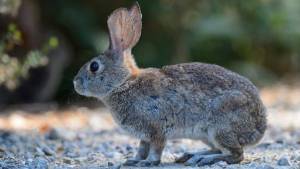Preventing Winter Damage to Plants

As we enjoy the fall days it’s also a time to get some tasks done to protect our trees and shrubs from environmental and animal damage this winter. As the phrase goes “An ounce of prevention is worth a pound of cure” and that definitely holds true for winter damage of plants whether caused by the weather or by a furry creature.
One of the most common issues I get calls about are frost cracks on trees. Maple trees are the most likely culprits however frost cracks can occur on ash, apple, crabapple, sycamore or any thin barked tree. Frost cracks occur in late spring or early fall typically on the south west side of the tree. During the day the sun warms the bark and underlying wood causing the sap to flow and the tissue to expand, then at night the temperature drops suddenly. The outer bark cools faster than the inner tissue and tries to contract. This difference in contraction damages the bark and the bark separates from the inner wood. This damage can be visible immediately or it might not show up for several years when the dead bark peels back in that area. Once the damage is done the tree will have to heal itself over years if it heals at all. There are a couple ways to prevent frost cracks. The first way is to avoid fertilizing or pruning trees late in the growing season to prevent active growth. In the fall wrap the trunk with tree wrap in the fall to help prevent the damage. If you do end up with frost cracks on trees provide a clean wound area. If the crack is clean with neat edges and no loose hanging bark, leave the tree alone but if there is a ragged tear trim off the ragged bark or remove the hanging pieces and allow it to heal on its own. Do not use wound treatment on the bark.
trees. Maple trees are the most likely culprits however frost cracks can occur on ash, apple, crabapple, sycamore or any thin barked tree. Frost cracks occur in late spring or early fall typically on the south west side of the tree. During the day the sun warms the bark and underlying wood causing the sap to flow and the tissue to expand, then at night the temperature drops suddenly. The outer bark cools faster than the inner tissue and tries to contract. This difference in contraction damages the bark and the bark separates from the inner wood. This damage can be visible immediately or it might not show up for several years when the dead bark peels back in that area. Once the damage is done the tree will have to heal itself over years if it heals at all. There are a couple ways to prevent frost cracks. The first way is to avoid fertilizing or pruning trees late in the growing season to prevent active growth. In the fall wrap the trunk with tree wrap in the fall to help prevent the damage. If you do end up with frost cracks on trees provide a clean wound area. If the crack is clean with neat edges and no loose hanging bark, leave the tree alone but if there is a ragged tear trim off the ragged bark or remove the hanging pieces and allow it to heal on its own. Do not use wound treatment on the bark.
The other day I was cleaning my garden and a rabbit jumped out of the tomatoes. In the winter rabbits and other small furry critters are going to come looking for food. As we get the garden ready for winter there are some steps we should take the keep the small furry critters from damaging plants. Mice tend to burrow in mulch and other debris so avoid piling those around thin barked trees. To prevent rabbits from chewing on trees use a 2-foot cylinder of 1-inch chicken mesh or a spiral plastic wrap around the trunk. This wire cylinder can be left on around the tree all year long as long as the wire doesn’t cut into the tree but the plastic needs removed every spring.
As our perennials and other plants go dormant in the fall it’s time to start mulching sensitive plants in to prevent the crowns from freezing or the freeze/thaw cycle heaving the plant out of the ground. As the leaves fall from the trees they make a wonderful mulch in flower beds around perennials and shrubs. I would also wait to cut perennials back for the winter, unless you had disease issues this year, till temperatures warm up in the spring. This residue will help trap leaves around the crowns of the plants and those debris are also where beneficial insects can overwinter. Just a reminder that you can keep some leaves on your lawn through the winter but if they start to pile up in one location try to spread them out to prevent the grass from being killed in that area.

Have questions? Contact our office where our Horticulture Extension Agent will assist you with questions.
Phone: (316) 321-9660
Email: callae@ksu.edu